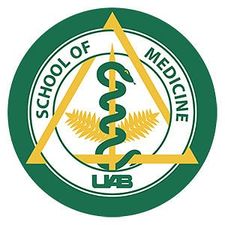|
|
| Line 14: |
Line 14: |
| ** [[Anupam Agarwal]] (interim), February-October 2013 | | ** [[Anupam Agarwal]] (interim), February-October 2013 |
| * [[Selwyn Vickers]], October 2013- | | * [[Selwyn Vickers]], October 2013- |
| <!--(Pasted from Wikipedia, for review)
| |
| *In 1960, [[Basil Hirschowitz|Dr. Basil Hirschowitz]] was the first to explore the stomach with his new invention, the fiber optic [[endoscope]], which is now in the [[Smithsonian Institution]].
| |
| *UAB heart surgeon, the late [[John W. Kirklin]], developed a computerized [[intensive care unit]] that became a model for modern ICUs around the world. They help improve care and reduce complications. Kirklin initially gained fame by improving the safety and usefulness of the heart-lung bypass pump.
| |
| *The [[Diabetes]] Research and Education Hospital was dedicated in March 1973, as the first public, university-affiliated diabetes hospital in the nation.
| |
| *In 1977, Dr. Richard Whitley administered systemic antiviral for the treatment of the deadly [[Herpes simplex virus|HSV]] (herpes simplex virus) encephalitis, leading to the world’s first effective treatment for a viral disease.
| |
| *The first use in the United States of color doppler [[echocardiography]] for visualizing internal cardiac structures was introduced by Dr. Navin C. Nanda and occurred at UAB Hospital in 1984.
| |
| *In 1986, Dr. [[Thomas Naum James|Thomas N. James]], then chairman of UAB's Department of Medicine, presided over the tenth [[World Congress of Cardiology]] held in Washington, DC.
| |
| *World's first genetically engineered mouse-human [[monoclonal antibody]] was used at University Hospital in the treatment of cancer in 1987.
| |
| *[[John Richard Montgomery|Dr. John Richard Montgomery]], known for co-implementing the environmental bubble used to protect [[David Vetter]], has served as the chief of pediatric programs at the Huntsville campus.
| |
| *The first simultaneous heart-kidney transplant in the [[Southeastern United States|Southeast]] was performed at UAB by Drs. [[David C. McGiffin]] and [[David Laskow]] in 1995.
| |
| *The journal ''[[Science (journal)|Science]]'' named three UAB faculty, Drs. [[Michael Saag]], George Shaw, and [[Beatrice Hahn]], among the top 10 AIDS researchers in the country, and highlighted the AIDS research program at UAB in 1996.
| |
| *The [[AIDS]] Vaccine Evaluation Unit (AVEU) became the first evaluation unit to enter a Phase III trail of an AIDS vaccine in 1999.
| |
| *UAB’s Kidney Transplantation Program is the world’s leading [[Organ transplant|transplant]] program, with more than 5,000 transplants being performed since 1968. In each of the last seven years, more kidney transplants have been performed at UAB than at any other institution in the world. UAB is also a national leader in other organ transplants.
| |
| *The UAB AIDS Center was the first to perform clinical trails of the protease inhibitor Indinavir (Crixivan), one of the first protease inhibitors used in the [triple drug cocktail] to fight [[HIV]].
| |
| *UAB researchers were the first to discover the protein that led to the development of the now well-known drug [[Viagra]], causing what some have called the second sexual revolution.<ref>[http://main.uab.edu/show.asp?durki=80905]</ref><ref>{{cite web|url=http://www.uab.edu/historical/uabchron.html#1900|title=UAB - Lister Hill Library - LHL Historical Collections|first=Lisa|last=Ennis|publisher=}}</ref>
| |
| *UAB hosts one of only 45 [[Medical Scientist Training Program]]s in the country. A highly selective program funded by grants from the National Institutes of Health, the UAB MSTP offers students the ability to earn both an MD and a PhD during a 6-8 year time period. During this time, all tuition is waived and a stipend of $25,000 per year is awarded. Generally, 6-10 students per year are admitted to the program.-->
| |
|
| |
|
| ==References== | | ==References== |
The UAB School of Medicine (founded in 1859 in Mobile as the Medical College of Alabama) is a graduate medical school at University of Alabama at Birmingham, with programs in Huntsville, Montgomery, Selma and Tuscaloosa.
The formerly independent Medical College of Alabama was moved onto the Tuscaloosa campus of the University of Alabama in 1920 under the direction of Abraham Flexner. An Extension Center opened in Birmingham in 1936. The medical program was formalized as a four-year Medical College by order of Governor Chauncey Sparks in 1943. Roy Kracke was appointed as the first dean of the school a year later, and oversaw the relocation of the program to Birmingham's Medical Center in 1945. The School merged with the Extension Center in 1966 to form the present University of Alabama in Birmingham under the auspices of the University of Alabama System. As part of UAB, the School of Medicine has been recognized a leading research and treatment center.
Currently, the UAB School of Medicine has 900 graduate students and 1,200 post-graduate resident fellows, along with 1,100 faculty members across 23 academic departments. It operates in conjunction with the UAB Medical Center ("University Hospital") and with affiliates, including Children's Hospital and the Birmingham VA Medical Center.
Deans
References
External links
